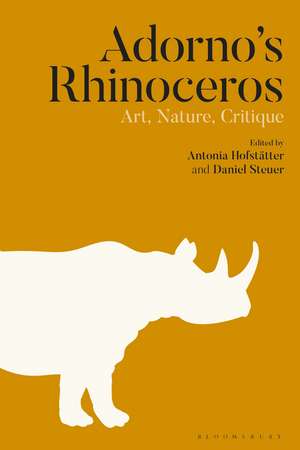Adorno’s Rhinoceros: Art, Nature, Critique
Editat de Dr Antonia Hofstätter, Dr Daniel Steueren Limba Engleză Paperback – 20 sep 2023
| Toate formatele și edițiile | Preț | Express |
|---|---|---|
| Paperback (1) | 190.68 lei 6-8 săpt. | |
| Bloomsbury Publishing – 20 sep 2023 | 190.68 lei 6-8 săpt. | |
| Hardback (1) | 539.18 lei 6-8 săpt. | +114.25 lei 6-10 zile |
| Bloomsbury Publishing – 23 feb 2022 | 539.18 lei 6-8 săpt. | +114.25 lei 6-10 zile |
Preț: 190.68 lei
Nou
Puncte Express: 286
Preț estimativ în valută:
36.49€ • 39.76$ • 30.75£
36.49€ • 39.76$ • 30.75£
Carte tipărită la comandă
Livrare economică 23 aprilie-07 mai
Preluare comenzi: 021 569.72.76
Specificații
ISBN-13: 9781350273177
ISBN-10: 1350273171
Pagini: 216
Ilustrații: 10 bw illus
Dimensiuni: 156 x 234 x 25 mm
Greutate: 0.3 kg
Editura: Bloomsbury Publishing
Colecția Bloomsbury Academic
Locul publicării:London, United Kingdom
ISBN-10: 1350273171
Pagini: 216
Ilustrații: 10 bw illus
Dimensiuni: 156 x 234 x 25 mm
Greutate: 0.3 kg
Editura: Bloomsbury Publishing
Colecția Bloomsbury Academic
Locul publicării:London, United Kingdom
Caracteristici
Offers a new angle on a key figure in the Continental tradition: through the figure of the rhinoceros, the contributors examine the relationship between art, nature and critique in his work
Notă biografică
Antonia Hofstätter is a Teaching Fellow in German studies at the University of Warwick, UK. She completed her PhD in 2017 with a thesis on T. W. Adorno's aesthetics at the University of Brighton, UK. She has contributed to Understanding Adorno, Understanding Modernism (Bloomsbury, 2020), The "Aging" of Adorno's Aesthetic Theory (2021), and Theodor W. Adorno: Ästhetische Theorie (2021).Daniel Steuer is an independent scholar living in Austria. Between 1989 and 2020, he taught European literature and social and political thought at Bangor University, Trinity College Dublin, the University of Sussex, and the University of Brighton, UK. He has published widely on Wittgenstein and Adorno, among other topics. His latest publication is a co-authored book, War and Algorithm (2019).
Cuprins
AcknowledgmentsList of IllustrationsList of Contributors 1. Introduction: The enigma of the rhinoceros, Antonia Hofstätter, (University of Warwick, UK) 2. In the name of the rhinoceros: expression beyond human intention, Camilla Flodin (Uppsala University, Sweden)3. The rhinoceros at the bottom of the sea: Adorno, Dürer and the silent eloquence of artworks, Antonia Hofstätter (University of Warwick, UK) 4. Just one line: reading T. W. Adorno on humans, artworks and animals, Lydia Goehr (Columbia University, USA)5. The mute animal, Alexander García Düttmann (Universität der Künste, Berlin, Germany)6. The speaking animal: on a metaphor of humanity, Sebastian Tränkle (Freie Universität, Germany)7. The gaze of the rhinoceros and the 'it' of Aesthetic Theory, Daniel Steuer (Independent Scholar, Austria)8. The muted animal, Daniel Herwitz (University of Michigan, USA)9. Epilogue: On the actuality of Adorno's rhinoceros - extraction, extinction and dignity, Daniel Steuer (Independent Scholar, Austria)Index
Recenzii
In these probing, eloquent, and sometimes lacerating essays, Adorno's continuing fascination with the rhinoceros is the occasion for commentary on his claim that art, at least now, emerges as the stand-in for an absent nature, for a nature facing extinction. A surprising and demanding addition to both Adorno studies, and human reflection on art and the approaching disaster.
Taking Adorno's enduring interest in the enigmatic rhinoceros as its starting point, this volume gives us a multi-faceted exploration of crucial dialectics in Adorno's thought, from the place of artworks in the dialectic of culture and nature to the distance between language and selfhood and the utopian promise in animals.
Adorno's Rhinoceros is a modern day bestiary of a single and singular animal, whose presence in art and culture stands in stark contrast to its imminent absence from the natural world. At once a marvelous collection of essays, and a collection of marvelous essays, each chapter has an intriguingly tight focus on one motif in Adorno's philosophy, and one line of his Aesthetic Theory. Yet the essays radiate into the diverse topics of 'dumb' animal nature, of the enigmatic nature of artworks and their muteness, and explore philosophical questions of selfhood, transcendence, metaphysics and secularization.
Centring on the enigmatic image of the rhinoceros, this brilliant volume of essays by established and emerging scholars explores how Adorno's bestiary dialectically configures an anticipation of the as yet unrealized promise of culture as well as the memory trace of its catastrophic failure.
Taking Adorno's enduring interest in the enigmatic rhinoceros as its starting point, this volume gives us a multi-faceted exploration of crucial dialectics in Adorno's thought, from the place of artworks in the dialectic of culture and nature to the distance between language and selfhood and the utopian promise in animals.
Adorno's Rhinoceros is a modern day bestiary of a single and singular animal, whose presence in art and culture stands in stark contrast to its imminent absence from the natural world. At once a marvelous collection of essays, and a collection of marvelous essays, each chapter has an intriguingly tight focus on one motif in Adorno's philosophy, and one line of his Aesthetic Theory. Yet the essays radiate into the diverse topics of 'dumb' animal nature, of the enigmatic nature of artworks and their muteness, and explore philosophical questions of selfhood, transcendence, metaphysics and secularization.
Centring on the enigmatic image of the rhinoceros, this brilliant volume of essays by established and emerging scholars explores how Adorno's bestiary dialectically configures an anticipation of the as yet unrealized promise of culture as well as the memory trace of its catastrophic failure.
